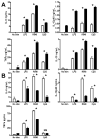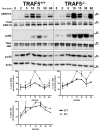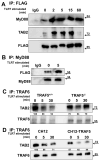TRAF5 negatively regulates TLR signaling in B lymphocytes
- PMID: 24259503
- PMCID: PMC3872259
- DOI: 10.4049/jimmunol.1301901
TRAF5 negatively regulates TLR signaling in B lymphocytes
Abstract
The cytoplasmic adaptor proteins TNFR-associated factor (TRAF)3 and TRAF6 are important mediators of TLR signaling. To our knowledge, we show in this study for the first time that another TRAF family member, TRAF5, is a negative regulator of TLR signaling. B lymphocytes from TRAF5(-/-) mice produced more IL-6, IL-12p40, IL-10, TNF-α, and IgM than did wild-type B cells after TLR stimulation. Consistent with these data, exogenous overexpression of TRAF5 in B cells inhibited TLR-mediated cytokine and Ab production. TLR stimulation of TRAF5-deficient B cells did not affect cell survival, proliferation, or NF-κB activation but resulted in markedly enhanced phosphorylation of the MAPKs ERK1/2 and JNK. TRAF5 negatively regulated TLR signaling in a cell-specific manner, because TRAF5(-/-) macrophages and dendritic cells showed less dramatic differences in TLR-mediated cytokine production than B cells. Following TLR stimulation, TRAF5 associated in a complex with the TLR adaptor protein MyD88 and the B cell-specific positive regulator of TLR signaling TAB2. Furthermore, TRAF5 negatively regulated the association of TAB2 with its signaling partner TRAF6 after TLR ligation in B cells. To our knowledge, these data provide the first evidence that TRAF5 acts as a negative regulator of TLR signaling.
Figures






References
-
- Aderem A, Ulevitch RJ. TLRs in the induction of the innate immune response. Nature. 2000;406:782–787. - PubMed
-
- Akira S. TLR signaling. J Biol Chem. 2003;278:38105–38108. - PubMed
-
- Ha H, Han D, Choi Y. TRAF-mediated TNFR-family signaling. In: Coligan John E, et al., editors. Current protocols in immunology. Unit11 19D Chapter 11. 2009. - PubMed
Publication types
MeSH terms
Substances
Grants and funding
LinkOut - more resources
Full Text Sources
Other Literature Sources
Molecular Biology Databases
Research Materials
Miscellaneous

